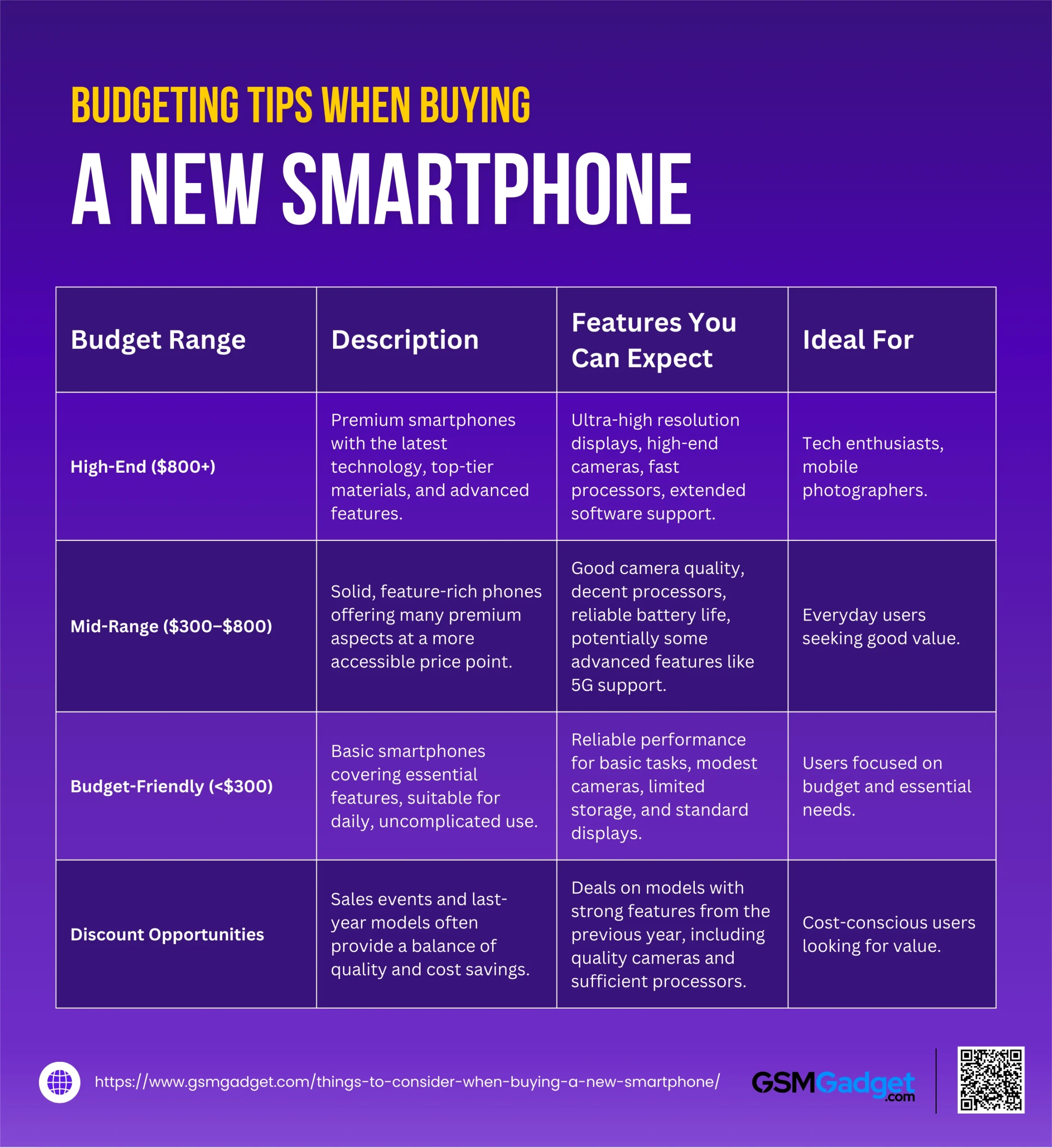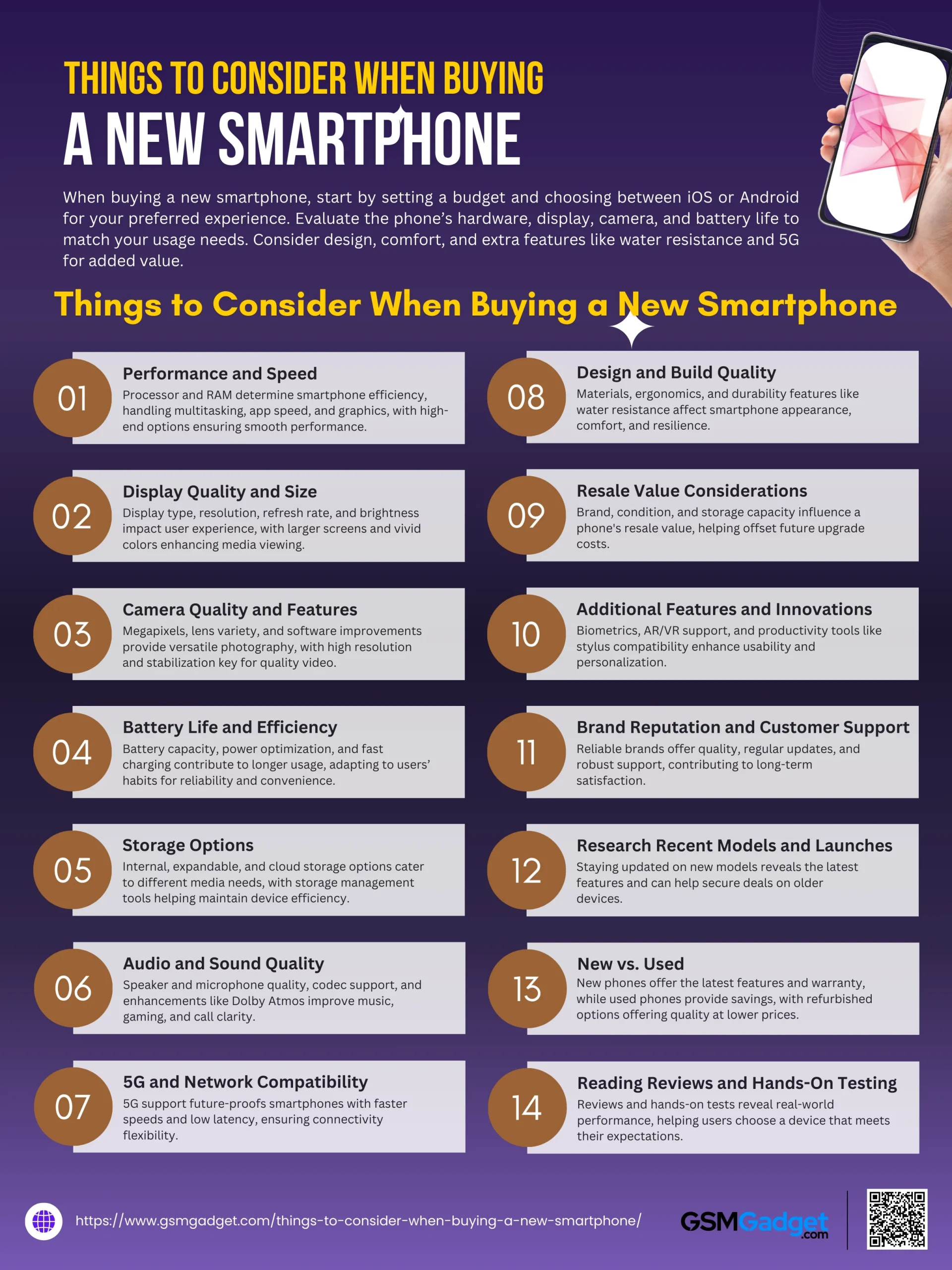When purchasing a new smartphone, it’s essential to evaluate several key factors to ensure the device aligns with your needs and preferences. Start by determining your budget, as this will narrow down your options and help you decide between flagship, mid-range, or budget models. Next, consider the operating system iOS offers a seamless experience with other Apple products, while Android provides greater customization and a wider range of devices. Assess the phone’s hardware, including processor performance, RAM, and storage capacity, to ensure it can handle your daily tasks and future software updates. The quality of the display, camera capabilities, and battery life are also crucial, especially if you frequently use your phone for media consumption, photography, or extended periods without charging. Finally, think about the phone’s design, size, and build materials to ensure comfort and durability, and check for additional features like water resistance, expandable storage, and 5G connectivity that may enhance your user experience.
 Determine Your Budget
Determine Your Budget
Setting a budget is an essential first step when buying a new smartphone. With such a wide range of prices and features available, knowing how much you’re willing to spend helps narrow down your options. By defining your budget early on, you can prioritize the features that are most important to you, ensuring you get the best value for your investment.
| Budget Range | Description | Features You Can Expect | Ideal For |
| High-End ($800+) | Premium smartphones with the latest technology, top-tier materials, and advanced features. | Ultra-high resolution displays, high-end cameras, fast processors, extended software support. | Tech enthusiasts, mobile photographers. |
| Mid-Range ($300–$800) | Solid, feature-rich phones offering many premium aspects at a more accessible price point. | Good camera quality, decent processors, reliable battery life, potentially some advanced features like 5G support. | Everyday users seeking good value. |
| Budget-Friendly (<$300) | Basic smartphones covering essential features, suitable for daily, uncomplicated use. | Reliable performance for basic tasks, modest cameras, limited storage, and standard displays. | Users focused on budget and essential needs. |
| Discount Opportunities | Sales events and last-year models often provide a balance of quality and cost savings. | Deals on models with strong features from the previous year, including quality cameras and sufficient processors. | Cost-conscious users looking for value. |
 Things to Consider When Buying a New Smartphone
Things to Consider When Buying a New Smartphone
1. Performance and Speed: Processor & RAM
When choosing a smartphone, performance and speed—primarily influenced by the processor (or chipset) and RAM—are crucial in ensuring smooth operation across tasks. High-end processors, like Apple’s A-series and Qualcomm’s Snapdragon 8, offer the best performance for demanding tasks, while mid-range and budget processors handle basic needs but may struggle with heavy applications. Multicore processors, especially those with Big. LITTLE architecture, optimize multitasking and battery life by balancing performance and efficiency. Clock speed, measured in GHz, affects responsiveness, with higher speeds supporting fast app launches and quick navigation. RAM levels, ranging from 2GB for light use to 12GB+ for power users, enable different multitasking capabilities, with higher RAM supporting seamless operation of heavy apps like games and professional tools. Graphics Processing Units (GPUs) further enhance visual tasks, critical for gaming and video editing, and AI capabilities in modern processors improve performance, battery efficiency, and features like photo quality and voice recognition.
2. Display Quality and Size
Smartphone display quality and size are essential for an optimal user experience, affecting everything from web browsing to gaming. Display types, such as LCD, known for brightness and affordability, and OLED/AMOLED, valued for vivid colors and contrast, play a key role. Resolution options vary from HD for basic clarity to QHD and 4K for ultra-sharp visuals, catering to users with diverse needs. Refresh rates, typically 60Hz but up to 120Hz for smoother motion, impact visual fluidity, particularly for gaming. Screen sizes range from compact (5–5.5 inches) for portability to large (6.5+ inches) for immersive viewing. Brightness and outdoor visibility are crucial for readability in sunlight, often enhanced by adaptive brightness. Lastly, color accuracy and HDR support elevate visual realism, making displays ideal for media consumption and photo editing, especially for users who prioritize high-quality visuals.
3. Camera Quality and Features
Smartphone camera quality is a top priority for many buyers, with features like megapixels, aperture, lens types, and software enhancements allowing phones to rival traditional cameras. Megapixels determine image detail but can be less critical than factors like lens quality and image processing. Aperture size influences light intake and depth of field, enhancing low-light shots and creating “bokeh” effects. Multiple lenses—wide, ultra-wide, and telephoto—offer versatility, while special lenses like macro and periscope enable creative close-ups and zoom. Image processing, including HDR and AI adjustments, enhances photo quality, and built-in editing tools simplify adjustments. For video, high resolution, frame rate, and stabilization (OIS/EIS) ensure smooth, sharp footage. Front and rear cameras are optimized for selfies and high-quality shots, respectively, making modern smartphone cameras versatile tools for both photography and video content creation.
4. Battery Life and Efficiency
Battery life and efficiency are crucial for smartphone users, influenced by factors such as battery capacity, power optimization software, fast charging, and battery health features. High-capacity batteries, typically 4000mAh and above, support all-day use, with software features like adaptive battery management enhancing power efficiency by learning user habits. Fast-charging technology allows quick power boosts, while wireless and reverse charging provide added convenience. Battery care settings, such as optimized charging, and thermal management prevent degradation, making them ideal for long-term use. Screen settings, like adaptive brightness and refresh rate control, help conserve power, and low-power modes ensure longevity in critical situations, providing flexibility and reliability based on user needs.
5. Storage Options
When choosing a smartphone, storage is a critical factor, especially for users who keep many apps, photos, videos, and files. Internal storage options range from 64GB to 512GB, with higher capacities offering future-proofing for heavier media and app use. Some Android phones support expandable storage through microSD cards, which can boost capacity affordably, though not all devices (like iPhones) allow this. Cloud storage services, like Google Drive and iCloud, provide off-device storage and backups, freeing up local space. Smartphones also offer tools for storage management, like cache clearing and smart suggestions for unused apps, to help maintain a clutter-free experience. Ultimately, the right balance between storage, RAM, and user needs—considering factors like cloud storage use and content volume—is key to optimal performance.
6. Audio and Sound Quality
Audio and sound quality are essential smartphone features, enhancing experiences like music streaming, gaming, and hands-free calls. Key factors include speaker quality (mono vs. stereo), speaker placement, and the availability of a 3.5mm headphone jack or USB-C/Lightning adapters for wired headphones. For wireless audio, Bluetooth version and audio codec support (e.g., aptX, LDAC) determine connection stability and sound fidelity. Additional sound enhancements, such as Dolby Atmos or customizable equalizers, enrich audio immersion. Microphone quality, especially with multiple mics and noise-canceling technology, improves call clarity and audio recordings, benefiting users in noisy environments.
7. 5G and Network Compatibility
As 5G technology expands, a 5G-compatible smartphone can future-proof your device by offering faster speeds, lower latency, and improved connectivity. Key factors to consider include 5G bands (Sub-6 GHz for broader coverage and mmWave for higher speeds but limited range), ensuring compatibility with your carrier’s specific 5G bands, and network support for both 4G LTE and 5G for seamless switching. Unlocked phones provide flexibility for changing carriers or international travel. 5G reduces latency, ideal for real-time applications, and offers faster data speeds for tasks like streaming. Battery efficiency is maintained with features like smart network switching, and mmWave may drain battery faster. With 5G networks expanding, a compatible phone ensures access to faster, more stable connectivity, which is valuable for users in regions where 5G is growing.
8. Design and Build Quality
Smartphone design and build quality are crucial, impacting durability, comfort, and user experience. Premium materials like glass and metal offer an elegant look and support wireless charging but may be fragile, while plastic and polycarbonate, common in budget models, are more resistant to damage and lighter. Ergonomic features, such as curved versus flat edges and strategically placed buttons, influence comfort and ease of use. Build durability is enhanced by protective display materials like Gorilla Glass and Ceramic Shield, which guard against scratches, while an IP rating for water and dust resistance improves resilience, especially for outdoor use and accidental exposure to elements.
9. Resale Value Considerations
Resale value is an important factor to consider when buying a new smartphone, as it can impact how much you’ll get back if you decide to upgrade in the future. Certain brands, like Apple and Samsung, tend to hold their value better due to strong demand, regular software updates, and high build quality. Factors that can boost a phone’s resale value include good condition, popular model status, and sufficient storage capacity, as these are typically more desirable to secondhand buyers. Additionally, opting for a phone with 5G capabilities and regular security updates can ensure it stays relevant longer, further enhancing its resale potential. By considering resale value when purchasing, you can help offset the cost of future upgrades, making your investment more financially sustainable.
10. Additional Features and Innovations
Modern smartphones offer various advanced features that elevate usability, security, and personalization. Biometric options, like face recognition and in-display fingerprint sensors, enhance security and convenience. Augmented and virtual reality support enables immersive experiences in gaming, shopping, and navigation. Productivity features, such as stylus compatibility for note-taking and sketching, as well as desktop modes and multi-window functions, transform smartphones into versatile tools for multitasking and creative work, adding functionality that caters to a broad range of user needs and preferences.
11. Brand Reputation and Customer Support
Brand reputation and customer support are crucial aspects to consider when purchasing a smartphone, as they can greatly impact your overall experience and satisfaction with the device. Established brands like Apple, Samsung, and Google have built strong reputations for reliability, quality, and consistent software updates, which often translate into higher user satisfaction. Additionally, reputable brands typically offer robust customer support, including accessible service centers, responsive online support, and warranty options, making it easier to resolve issues if they arise. A good brand reputation also reflects how well a company stands behind its products and addresses user feedback, which can be reassuring if you plan to keep your phone for several years. Opting for a brand with solid customer support and a positive reputation can give you confidence in your purchase and ensure help is available when you need it.
12. Research Recent Models and Launches
Keeping up with recent models and launches is a smart step before buying a smartphone, as new releases often bring the latest technology, features, and design improvements. Manufacturers like Apple, Samsung, and Google regularly launch new models, each iteration typically offering enhanced performance, better cameras, and updated software. Researching recent launches can also help you understand current trends, like advancements in 5G, camera technology, and battery life, giving you a clearer picture of what’s available. Additionally, knowing when new models are released can sometimes mean better deals on previous models, allowing you to get high-quality devices at a more affordable price. By staying informed about the latest smartphone models, you can make a purchase that reflects both your budget and your desire for up-to-date technology.
13. New vs. Used: Making the Right Choice
Choosing between a new and used smartphone depends on your budget, preferences, and priorities. A new phone comes with the latest features, a full warranty, and peace of mind, as you won’t have to worry about previous wear and tear or hidden issues. However, a used phone can offer substantial savings, allowing you to get a higher-end model for a lower price. If you’re considering a used phone, it’s wise to purchase from reputable sellers and check for issues like battery health, screen quality, and software compatibility. Refurbished models from certified retailers are another great option, as they often come with a limited warranty and have been professionally restored. Weighing the benefits and risks of new versus used will help you make the right choice for both your needs and budget.
14. Reading Reviews and Hands-On Testing
Reading reviews and, if possible, doing a hands-on test are valuable steps in choosing the right smartphone. Reviews from reputable sources and users provide insights into real-world performance, highlighting strengths and weaknesses you might not find in product descriptions. For example, you can learn about battery life, camera quality in different conditions, software smoothness, and any potential issues, like overheating or durability concerns. Hands-on testing, whether at a store or through a friend’s device, allows you to feel the build quality, assess the screen’s vibrancy, and gauge how comfortable the phone is to hold and use. This direct experience, combined with insights from reviews, helps you make a more informed decision and ensures the phone aligns with your preferences and expectations.
Conclusion
Choosing the right smartphone involves balancing a variety of factors, from budget and performance to design and unique features. By considering essential aspects like battery life, display quality, storage options, and network compatibility, along with newer innovations that fit your lifestyle, you can find a device that meets both your current needs and future goals. Whether you prioritize camera quality, brand reputation, or simply want a reliable phone with strong resale value, thoughtful research can guide you to the best choice. Ultimately, taking the time to compare models, read reviews, and test devices will ensure that you invest in a smartphone you’ll enjoy using every day, giving you the performance, durability, and features that matter most.
